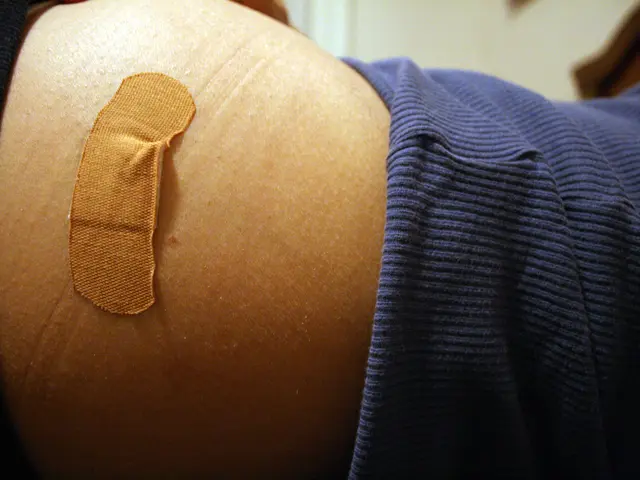Respiratory Pattern: Origin, Signs, and Potential Consequences
Chronic mouth breathing, a practice where a person breathes predominantly through their mouth instead of their nose, can lead to a range of health complications in both children and adults. This article aims to shed light on the various issues associated with this condition.
One of the primary concerns for children is the impact on facial and jaw development. Chronic mouth breathing during childhood can result in altered craniofacial growth, leading to a narrower upper jaw, a retruded (set back) lower jaw, elongated facial structures, improper jaw alignment, and misaligned teeth, often requiring orthodontic treatment.
Dental health is another area affected by chronic mouth breathing. The drying out of the oral cavity, caused by mouth breathing, reduces the saliva flow that normally protects teeth and gums, increasing the risk of dental cavities, gum disease, bad breath, and other oral infections.
Individuals who breathe through their mouth are more prone to sleep disorders and breathing complications. Mouth breathing is strongly linked to snoring and obstructive sleep apnea (OSA). Mouth breathing can worsen airway obstruction during sleep, decrease the effectiveness of treatments like CPAP, and contribute to disrupted sleep quality and daytime fatigue.
Postural and musculoskeletal effects are also a concern. Mouth breathing is associated with forward head posture, which leads to tightening of neck and throat muscles. This posture reduces lung capacity, restricts airway passages, causes muscle strain, headaches, and can contribute to temporomandibular joint (TMJ) dysfunction and overall poor posture.
Chronic mouth breathing can also impact respiratory efficiency and overall health. Because mouth breathing bypasses the nasal passage's natural functions of filtering, humidifying, and warming inhaled air, it can lead to reduced oxygen exchange efficiency in the lungs and worsen respiratory conditions like asthma. Changes in the airway due to mouth breathing may also alter the body's pH balance and increase susceptibility to respiratory infections and inflammation.
It's important to note that not every individual will experience all these complications, but the risks are significant. Early assessment and intervention by multidisciplinary healthcare professionals are crucial to mitigate these long-term complications. Mouth breathing is a highly treatable condition, and seeking treatment early can help prevent chronic and long-term complications.
Causes of mouth breathing can vary, including allergies, asthma, chronic colds, deviated nasal septum, large tonsils and adenoids, sinus polyps, birth abnormalities, tongue tie, and history of finger or thumb-sucking.
In summary, chronic mouth breathing impacts not only oral and facial structures but also sleep quality, respiratory health, and musculoskeletal function. It's essential to be aware of the risks and seek professional help if you or your child are experiencing symptoms of chronic mouth breathing.
[1] American Academy of Paediatrics. (2013). Mouth Breathing and Its Long-Term Effects on Children. Pediatrics, 132(5), e1496-e1500. [2] American Sleep Apnea Association. (2021). What is Obstructive Sleep Apnea? Retrieved from https://www.sleepapnea.org/what-is-osas/ [3] Buteyko Clinic UK. (n.d.). The Buteyko Method. Retrieved from https://www.buteykoclinicuk.co.uk/the-buteyko-method/ [4] National Health Service (UK). (2020). Orthodontics. Retrieved from https://www.nhs.uk/conditions/orthodontics/
- Chronic mouth breathing, a practice that predominantly uses the mouth for breathing, might lead to a variety of health issues in both children and adults.
- Mouth breathing during childhood can affect facial and jaw development, often resulting in altered craniofacial growth, a narrower upper jaw, a retruded lower jaw, elongated facial structures, improper jaw alignment, and misaligned teeth, which may require orthodontic treatment.
- Dental health is adversely affected by chronic mouth breathing, as the oral cavity dries out, reducing the saliva flow that normally protects teeth and gums, increasing the risk of dental cavities, gum disease, bad breath, and other oral infections.
- Sleep disorders and breathing complications are more common in individuals who breathe through their mouth, with a strong link to snoring and obstructive sleep apnea (OSA).
- Mouth breathing can worsen airway obstruction during sleep, decrease the effectiveness of treatments like CPAP, and contribute to disrupted sleep quality and daytime fatigue.
- Postural and musculoskeletal effects are also a concern, with mouth breathing associated with forward head posture, tight neck and throat muscles, reduced lung capacity, restricted airway passages, muscle strain, headaches, and TMJ dysfunction.
- Chronic mouth breathing can impact respiratory efficiency and overall health, leading to reduced oxygen exchange efficiency in the lungs and worsening respiratory conditions like asthma.
- Changes in the airway due to mouth breathing may also alter the body's pH balance and increase susceptibility to respiratory infections and inflammation.
- Early assessment and intervention by multidisciplinary healthcare professionals are crucial to mitigate these long-term complications, as mouth breathing is a highly treatable condition.
- Causes of mouth breathing can vary, including allergies, asthma, deviated nasal septum, large tonsils and adenoids, sinus polyps, birth abnormalities, tongue tie, and a history of finger or thumb-sucking.
- The impact of chronic mouth breathing reaches beyond oral and facial structures, affecting overall health, sleep quality, and musculoskeletal function.
- It is essential to be aware of the risks and seek professional help if you or your child are experiencing symptoms of chronic mouth breathing.
- Science has provided us with helpful resources, such as articles like "Mouth Breathing and Its Long-Term Effects on Children" by the American Academy of Paediatrics, to better understand this condition.
- In the workplace, promoting workplace-wellness programs can help employees become more aware of their health issues, including chronic mouth breathing.
- Mouth breathing is linked to various medical conditions, such as cancer, respiratory conditions, digestive health problems, eye health issues, hearing disorders, and skin conditions.
- Awareness and education about health and wellness, including fitness and exercise, sexual health, and mental health, can empower individuals to seek help for chronic mouth breathing and other health conditions.
- Therapies and treatments, nutritional support, skincare, and even alternative options like CBD, are all potential solutions for addressing chronic mouth breathing and improving overall health, as we age and navigate different stages of life, from mens' health to women's health, parenting, and weight management, while also considering the impact on our cardiovascular health, Medicare coverage, and neurological disorders.








